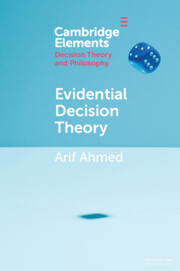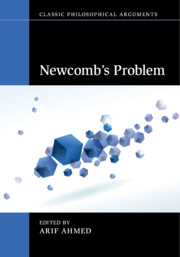55 results
12 - “Considered in Isolation”
-
-
- Book:
- Kripke's <i>Wittgenstein on Rules and Private Language</i> at 40
- Published online:
- 22 February 2024
- Print publication:
- 08 February 2024, pp 220-237
-
- Chapter
- Export citation
Identification of weak links in production technology for bridging the canola yield-gap in Punjab, Pakistan
-
- Journal:
- The Journal of Agricultural Science / Volume 161 / Issue 2 / April 2023
- Published online by Cambridge University Press:
- 22 February 2023, pp. 241-253
-
- Article
- Export citation
Factor Associated with HIV/AIDS knowledge among males: Findings from 2017-18 Pakistan Demographic and Health Survey
-
- Journal:
- Journal of Biosocial Science / Volume 55 / Issue 6 / November 2023
- Published online by Cambridge University Press:
- 16 January 2023, pp. 1169-1177
-
- Article
- Export citation

Evidential Decision Theory
-
- Published online:
- 24 September 2021
- Print publication:
- 21 October 2021
-
- Element
- Export citation
Choosing for Changing Selves, Richard Pettigrew. Oxford: Oxford University Press, 2019, xiv + 253 pages.
-
- Journal:
- Economics & Philosophy / Volume 37 / Issue 3 / November 2021
- Published online by Cambridge University Press:
- 15 December 2020, pp. 484-489
-
- Article
- Export citation
Karyological analysis of bitter gourd (Momordica charantia L., Cucurbitaceae) from Southeast Asian countries – Corrigendum
-
- Journal:
- Plant Genetic Resources / Volume 18 / Issue 3 / June 2020
- Published online by Cambridge University Press:
- 17 July 2020, p. 200
-
- Article
-
- You have access
- HTML
- Export citation
Consumption of fruit and vegetables and the risk of type 2 diabetes: a 4-year longitudinal study among Swedish adults
-
- Journal:
- Journal of Nutritional Science / Volume 9 / 2020
- Published online by Cambridge University Press:
- 02 April 2020, e14
-
- Article
-
- You have access
- Open access
- HTML
- Export citation
Belief and religious ‘belief’
-
- Journal:
- Religious Studies / Volume 56 / Issue 1 / March 2020
- Published online by Cambridge University Press:
- 06 May 2019, pp. 80-94
- Print publication:
- March 2020
-
- Article
- Export citation
Chapter 4 - Self-Control and Hyperbolic Discounting
-
-
- Book:
- Self-Control, Decision Theory, and Rationality
- Published online:
- 29 November 2018
- Print publication:
- 06 December 2018, pp 96-120
-
- Chapter
- Export citation
Contents
-
- Book:
- Newcomb's Problem
- Published online:
- 15 October 2018
- Print publication:
- 01 November 2018, pp v-v
-
- Chapter
- Export citation
References
-
- Book:
- Newcomb's Problem
- Published online:
- 15 October 2018
- Print publication:
- 01 November 2018, pp 221-231
-
- Chapter
- Export citation
Copyright page
-
- Book:
- Newcomb's Problem
- Published online:
- 15 October 2018
- Print publication:
- 01 November 2018, pp iv-iv
-
- Chapter
- Export citation
3 - The “Why Ain’cha Rich?” Argument
-
-
- Book:
- Newcomb's Problem
- Published online:
- 15 October 2018
- Print publication:
- 01 November 2018, pp 55-72
-
- Chapter
- Export citation
Introduction
-
-
- Book:
- Newcomb's Problem
- Published online:
- 15 October 2018
- Print publication:
- 01 November 2018, pp 1-18
-
- Chapter
- Export citation
Contributors
-
- Book:
- Newcomb's Problem
- Published online:
- 15 October 2018
- Print publication:
- 01 November 2018, pp vi-vi
-
- Chapter
- Export citation
Index
-
- Book:
- Newcomb's Problem
- Published online:
- 15 October 2018
- Print publication:
- 01 November 2018, pp 232-234
-
- Chapter
- Export citation
Acknowledgments
-
- Book:
- Newcomb's Problem
- Published online:
- 15 October 2018
- Print publication:
- 01 November 2018, pp vii-viii
-
- Chapter
- Export citation

Newcomb's Problem
-
- Published online:
- 15 October 2018
- Print publication:
- 01 November 2018
Novel dual band patch antenna With Gap coupled composite right/left-handed transmission line
-
- Journal:
- International Journal of Microwave and Wireless Technologies / Volume 11 / Issue 1 / February 2019
- Published online by Cambridge University Press:
- 07 August 2018, pp. 87-93
-
- Article
- Export citation
Application of avian cytokines as immuno-modulating agents
-
- Journal:
- World's Poultry Science Journal / Volume 74 / Issue 1 / March 2018
- Published online by Cambridge University Press:
- 26 February 2018, p. 158
- Print publication:
- March 2018
-
- Article
-
- You have access
- HTML
- Export citation



